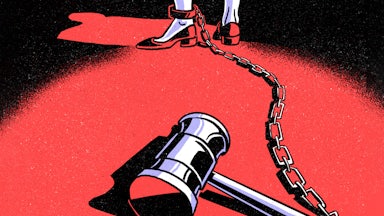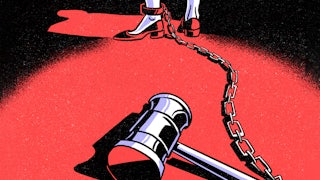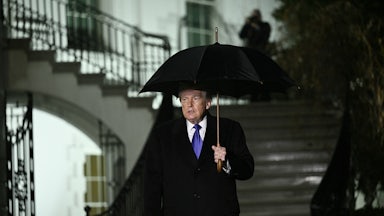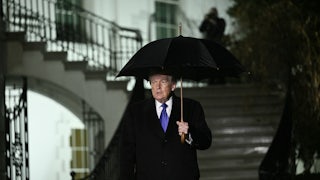Should the leaked draft decision that recently ended up in the hands of reporters at Politico eventually become the majority holding in Dobbs v. Jackson Women’s Health Organization—and thus overturn Roe v. Wade and Planned Parenthood v. Casey, the two landmark decisions that currently undergird the right to an abortion—the country will face immediate upheaval across the legal landscape as rights that women have held for decades suddenly vanish. And it’s not a stretch to emphasize how immediately American life is going to change. In many states across the country, the impact will be as close to instantaneous as anything in the legal dimension can be, thanks to the fact that numerous states have passed so-called “trigger laws,” which will drop immediate rollbacks of reproductive freedom the minute the Supreme Court gives the OK.
Trigger laws come in various shapes and sizes; some are more ambitious than others, while a few are little more than placeholders until state lawmakers can figure out how draconian they want to be. The existence of trigger laws speaks to the profound faith that social conservatives have had in their mission: the belief that the Supreme Court would one day come through on the promise of ending Roe. But in many ways, that they exist at all indicates that anti-abortion lawmakers haven’t fully contemplated what the post-Roe landscape will look like. The authors of these laws, after all, neither fully anticipated the future of reproductive medicine nor the possibility of a Supreme Court that suddenly had a 6–3 archconservative majority. These laws may snap into place the moment the deed is done, but it’s likely that they won’t be the final say on the matter.
Trigger laws are clustered in two parts of the nation’s midsection. One of them follows the Mormon Belt through Idaho and Utah and then stretches east through Wyoming and the Dakotas. The other is centered on the terminus of the Mississippi River. Arkansas, Kentucky, Louisiana, Mississippi, Missouri, and Tennessee all have trigger laws in some form. So do Oklahoma and Texas, their western neighbors.
What separates a trigger law from the arsenal of other abortion bans and restrictions is its contingency. Each trigger law says that its provisions only go into effect if the Supreme Court ever overturned Roe v. Wade. (Some would also kick in if, alternatively, the states amended the Constitution to ban abortion or if Congress passed a bill to do so.) That distinguishes them from other laws that restrict or effectively ban abortion in defiance of Roe. States can have both types of laws on their books: Mississippi, for instance, has a trigger law in addition to the 15-week ban that is at issue in Dobbs.
Trigger laws are also distinct from pre-Roe bans on abortion that remain on the statute books in some states. According to the Guttmacher Institute, nine states did not repeal or revise their prohibitions on the procedure after 1973. In most of those states, the pre-Roe bans are semi-symbolic because state lawmakers have since passed laws to ban it in other ways. In Arizona, Michigan, and Wisconsin, however, those laws could be enforced again if the Supreme Court overturns Roe without further action by the state legislature. Michigan Attorney General Dana Nessel, a Democrat, said that her office wouldn’t enforce the state’s 1931 ban in that event, but she also wouldn’t be able to stop local prosecutors from enforcing it if they choose.
Pre-Roe bans are currently moribund because the courts would block them under Roe if someone tried to enforce them. Trigger laws, by comparison, operate in a middle space of sorts. Since they haven’t taken effect, there is nothing to enforce and nothing that could prompt a legal challenge. And if they ever do take effect, then, by definition, there will be no grounds to challenge them since Roe will be overturned. Unlike other state laws restricting abortion, they also do not come with expensive legal bills that, until recently, would have led to an almost certain defeat.
Anti-abortion trigger laws may be unique in American legislative history. There appears to be no other issue where multiple states have passed laws that explicitly only take effect if the Supreme Court overturns one of its own previous rulings. In that sense, they also double as a series of markers on the conservative legal movement’s quest to demolish Roe. The current slate of trigger laws dates back to 2005, when South Dakota passed one in the event that the Supreme Court overturned the 1973 ruling. It had good reason to believe it might be possible: Sandra Day O’Connor, who had voted in favor of abortion rights as a justice, announced her retirement that year, and George W. Bush nominated John Roberts to replace her. When then-Chief Justice William Rehnquist died later that summer, Bush renominated Roberts for the top job and then eventually named Samuel Alito, the author of the Dobbs draft, to replace him.
Louisiana passed a similar law in 2006, followed by Mississippi and North Dakota in 2007. But the high court still lacked five votes to overturn Roe. Anthony Kennedy, who voted in favor of some abortion restrictions but declined to go further, became the court’s swing vote. In 2007, the Supreme Court upheld the federal Partial-Birth Abortion Ban Act. Kennedy, writing for the court, rejected the legal challenges to the law as insufficient and held that it didn’t violate the undue-burden standard articulated in Casey. Though the law’s anti-abortion proponents won the case, they didn’t shake loose any signs that Kennedy would reverse himself on the issue.
It wasn’t until Kennedy’s retirement in 2018 that some states once again began to anticipate Roe’s imminent demise. After Justice Brett Kavanaugh’s confirmation that fall, Republican-led states passed a deluge of anti-abortion laws in hopes of triggering, so to speak, a final showdown on abortion rights at the Supreme Court. Arkansas, Kentucky, Missouri, and Tennessee passed their trigger laws in 2019, with Idaho and Utah following them in 2020 and Oklahoma and Texas in 2021. Wyoming, the most recent state to pass such a law, joined them earlier this year.
While they all share the same basic function, each of the post-Roe trigger laws would operate differently in practice. All 13 states with trigger bans would still allow doctors to perform an abortion if the mother’s life was at stake, or at least cite medical necessity as an affirmative defense in court. But only five of the 13 trigger laws would allow women to obtain an abortion in the event of rape or incest. That exemption used to be standard fare in abortion bans and restrictions, but as The Atlantic’s Elaine Godfrey recently noted, it’s increasingly common for newer restrictions to omit them. That shift may be for philosophical reasons or for political ones as red-state governors try to one-up each other on their anti-abortion credentials.
An urgent question for the post-Roe landscape is how far these states can and will go to ban abortion pills, which could offer women an alternative in places where abortion clinics are sparse or shut down. Trigger laws are generally mixed on the subject. Arkansas, Kentucky, Mississippi, North Dakota, Oklahoma, and Tennessee ban abortion pills only if they are administered after the woman knows she is pregnant, which could cover drugs like mifepristone but would likely exclude birth-control pills and Plan B, which take effect before pregnancy would show up in test results. Other state laws are more ambiguous: Idaho’s trigger law explicitly does not cover birth-control pills but could cover Plan B because it applies if the woman knows there is a “reasonable likelihood” that the drug’s use will end a pregnancy.
Most of the trigger laws either explicitly prohibit charging the woman for whom the abortion takes place. Others are ambiguous on the subject, either by targeting only physicians or, in the case of Texas, by not addressing the question at all. Anti-abortion groups often claim that they do not want the women punished for it, most notably when then-candidate Donald Trump said there “has to be some form of punishment” for obtaining it. (He later walked back that claim.) That may not hold for long. Louisiana lawmakers advanced a bill this week that could open the door to homicide charges against pregnant women. And as my colleague Melissa Gira Grant has noted, there is already a movement afoot in some jurisdictions for law enforcement agencies to scrutinize pregnant women who miscarry or give birth to stillborn children even while Roe is intact.
What’s striking about some of the trigger laws is how minimalistic they are. Some states lay out how courts are supposed to weigh defenses by doctors who perform them out of medical necessity. Others include caveats and exceptions that recognize the complicated nature of obstetric medicine and emergency situations. And then there are states like South Dakota, whose first-in-the-nation trigger law could almost fit in a tweet. It simply states that anyone who administers an abortion or prescribes or procures drugs to induce one for any reason other than medical necessity is guilty of a felony crime. “This Act is effective on the date that the states are recognized by the United States Supreme Court to have the authority to prohibit abortion at all stages of pregnancy,” it declared.
There may be no better illustration of the difficult questions that some states will soon grapple with than these laws. Drafted as semi-symbolic gestures to an anti-abortion movement that sought a sense of momentum, some of these laws could have very real consequences in the next two months. Their ambiguous wordings and sometimes poorly defined scope could produce enforcement headaches for the states that enacted them when Dobbs comes down. Abortion-rights advocates have occasionally compared the anti-abortion movement to the dog that catches the car when considering what a post-Roe landscape will look like. If that’s the case, these trigger laws might be where things start to go awry for them—and for the millions of women who will have to live under them.










